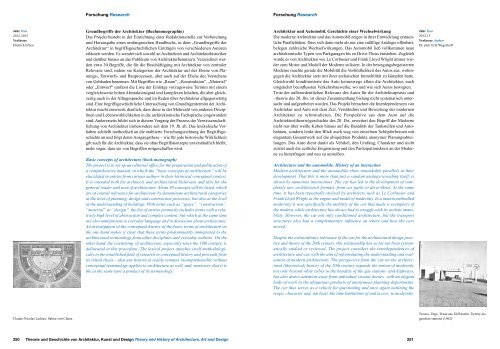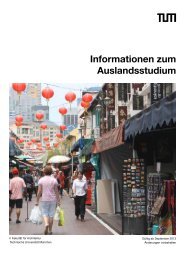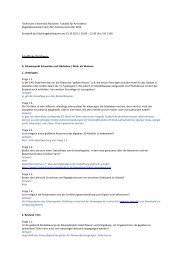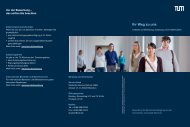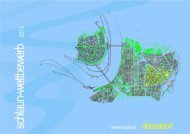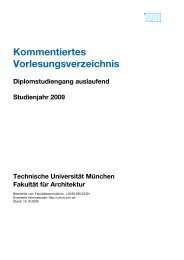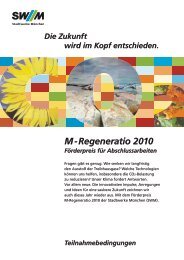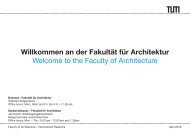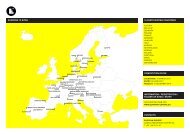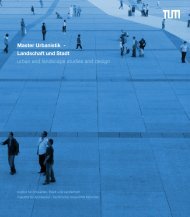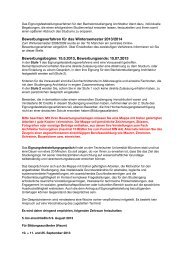Institute Institutes - Fakultät für Architektur - TUM
Institute Institutes - Fakultät für Architektur - TUM
Institute Institutes - Fakultät für Architektur - TUM
Erfolgreiche ePaper selbst erstellen
Machen Sie aus Ihren PDF Publikationen ein blätterbares Flipbook mit unserer einzigartigen Google optimierten e-Paper Software.
Jahr Year<br />
2012-2015<br />
Verfasser<br />
Dietrich Erben<br />
Claude-Nicolas Ledoux, Saline von Chaux<br />
Forschung Research Forschung Research<br />
Grundbegriffe der <strong>Architektur</strong> (Buchmonographie)<br />
Das Projekt besteht in der Einrichtung einer Redaktionsstelle zur Vorbereitung<br />
und Herausgabe eines umfangreichen Handbuchs, in dem „Grundbegriffe der<br />
<strong>Architektur</strong>“ in begriffsgeschichtlichen Einträgen von verschiedenen Autoren<br />
erläutert werden. Es wendet sich sowohl an Architekten und <strong>Architektur</strong>historiker<br />
und darüber hinaus an das Publikum von <strong>Architektur</strong>benutzern. Verzeichnet werden<br />
etwa 30 Begriffe, die <strong>für</strong> die Beschäftigung mit <strong>Architektur</strong> von zentraler<br />
Relevanz sind, indem sie Kategorien der <strong>Architektur</strong> auf der Ebene von Planungs-,<br />
Entwurfs- und Bauprozessen, aber auch auf der Ebene des Verstehens<br />
von Gebäuden benennen. Mit Begriffen wie „Raum“, „Konstruktion“, „Material“<br />
oder „Entwurf“ umfasst die Liste der Einträge vorzugsweise Termini mit einem<br />
vergleichsweise hohen Abstraktionsgrad und komplexen Inhalten, die aber gleichzeitig<br />
auch in der Alltagssprache und im Reden über <strong>Architektur</strong> allgegenwärtig<br />
sind. Eine begriffsgeschichtliche Untersuchung von Grundlagentermini der <strong>Architektur</strong><br />
macht einerseits deutlich, dass diese in der Mehrzahl von anderen Disziplinen<br />
und Lebenswirklichkeiten in die architektonische Fachsprache eingewandert<br />
sind. Andererseits bildet sich in diesem Vorgang der Prozess der Verwissenschaftlichung<br />
von <strong>Architektur</strong> insbesondere seit dem 19. Jh. ab. Das lexikalische Vorhaben<br />
schließt methodisch an die etablierte Forschungsrichtung der Begriffsgeschichte<br />
an und folgt deren Ausgangsthese – wie <strong>für</strong> jede historische Wirklichkeit<br />
gilt auch <strong>für</strong> die <strong>Architektur</strong>, dass sie ohne Begriffskonzepte unverständlich bleibt,<br />
mehr sogar, dass sie von Begriffen mitgeschaffen wird.<br />
Basic concepts of architecture (book monograph)<br />
The project is to set up an editorial office for the preparation and publication of<br />
a comprehensive manual, in which the “basic concepts of architecture” will be<br />
elucidated in entries from various authors in their historical conceptual context.<br />
It is intended both for architects and architectural historians and also for the<br />
general reader and user of architecture. About 30 concepts will be listed, which<br />
are of central relevance for architecture by denominate architectural categories<br />
at the level of planning, design and construction processes, but also at the level<br />
of the understanding of buildings. With terms such as “space”, “construction”,<br />
“material” or “design”, the list of entries primarily includes terms with a relatively<br />
high level of abstraction and complex content, but which at the same time<br />
are also omnipresent in everyday language and in discussion about architecture.<br />
An investigation of the conceptual history of the basic terms of architecture on<br />
the one hand makes it clear that these terms predominantly immigrated to the<br />
architectural terminology from other disciplines and everyday realities. On the<br />
other hand, the scientising of architecture, especially since the 19th century, is<br />
delineated in this procedure. The lexical project attaches itself methodologically<br />
to the established field of research in conceptual history and proceeds from<br />
its initial thesis – that any historical reality remains incomprehensible without<br />
conceptual terminology applies to architecture as well, and, moreover, that it is<br />
the at the same time a product of its terminology.<br />
<strong>Architektur</strong> und Automobil. Geschichte einer Wechselwirkung<br />
Die moderne <strong>Architektur</strong> und das Automobil zeigen in ihrer Entwicklung erstaunliche<br />
Parallelitäten. Dass sich darin mehr als nur eine zufällige Analogie offenbart,<br />
belegen zahlreiche Wechselwirkungen. Das Automobil ließ vollkommen neue<br />
architektonische Typen von Parkgaragen bis zu Drive-Thrus entstehen. Zugleich<br />
wurde es von Architekten wie Le Corbusier und Frank Lloyd Wright immer wieder<br />
zum Motor und Modell der Moderne stilisiert. In der bewegungsbegeisterten<br />
Moderne machte gerade die Mobilität die Vorbildlichkeit des Autos aus, wohingegen<br />
die <strong>Architektur</strong> stets mit ihrer archaischen Immobilität zu kämpfen hatte.<br />
Gleichwohl konditionierte das Auto keineswegs allein die <strong>Architektur</strong>, auch<br />
umgekehrt beeinflussten Verkehrsbauwerke, wo und wie sich Autos bewegten.<br />
Trotz der außerordentlichen Relevanz des Autos <strong>für</strong> die <strong>Architektur</strong>praxis und<br />
–theorie des 20. Jhs. ist dieser Zusammenhang bislang nicht systematisch untersucht<br />
und aufgearbeitet worden. Das Projekt betrachtet die Interdependenzen von<br />
Architekur und Auto mit dem Ziel, Verständnis und Bewertung der modernen<br />
<strong>Architektur</strong> zu reformulieren. Die Perspektive aus dem Auto auf die<br />
<strong>Architektur</strong>(theorie)geschichte des 20. Jhs. erweitert den Begriff der Moderne<br />
nicht nur über weiße Kuben hinaus auf die Banalität der Tankstellen und Autobahnen,<br />
sondern lenkt den Blick auch weg von einzelnen Schöpferheroen mit<br />
elegantem Gesamtwerk auf die ubiquitären Produkte anonymer Planungsabteilungen.<br />
Das Auto dient damit als Vehikel, den Umfang, Charakter und nicht<br />
zuletzt auch die zeitliche Eingrenzung und den Partizipationskreis an der Moderne<br />
zu hinterfragen und neu zu umreißen.<br />
Architecture and the automobile. History of an interaction<br />
Modern architecture and the automobile show remarkable parallels in their<br />
development. That this is more than just a random analogy revealing itself, is<br />
shown by numerous interactions. The car has led to the development of completely<br />
new architectural formats, from car parks to drive-thrus. At the same<br />
time, it has been repeatedly stylised by architects such as Le Corbusier and<br />
Frank Lloyd Wright as the engine and model of modernity. In a motion-enthralled<br />
modernity it was specifically the mobility of the car that made it exemplary of<br />
the modern, while architecture has always had to struggle with its archaic immobility.<br />
However, the car not only conditioned architecture, but the transport<br />
structures also had a complementary influence on where and how the cars<br />
moved.<br />
Despite the extraordinary relevance of the car for the architectural design practice<br />
and theory of the 20th century, this relationship has so far not been systematically<br />
studied or reviewed. The project considers the interdependences of<br />
architecture and car, with the aim of reformulating the understanding and evaluation<br />
of modern architecture. The perspective from the car on the architectural<br />
(theoretical) history of the 20th century expands the notion of modernity<br />
not only beyond white cubes to the banality of the gas stations and highways,<br />
but also draws attention away from individual creator heroes with an elegant<br />
body of work to the ubiquitous products of anonymous planning departments.<br />
The car thus serves as a vehicle for questioning and once again outlining the<br />
scope, character and, not least, the time limitations of and access to modernity.<br />
250 Theorie und Geschichte von <strong>Architektur</strong>, Kunst und Design Theory and History of Architecture, Art and Design<br />
251<br />
Jahr Year<br />
2012-15<br />
Verfasser Author<br />
Dr. phil. Erik Wegerhoff<br />
Texaco, Vega, Texas aus Ed Ruscha: Twenty-six<br />
gasoline stations (1962)


